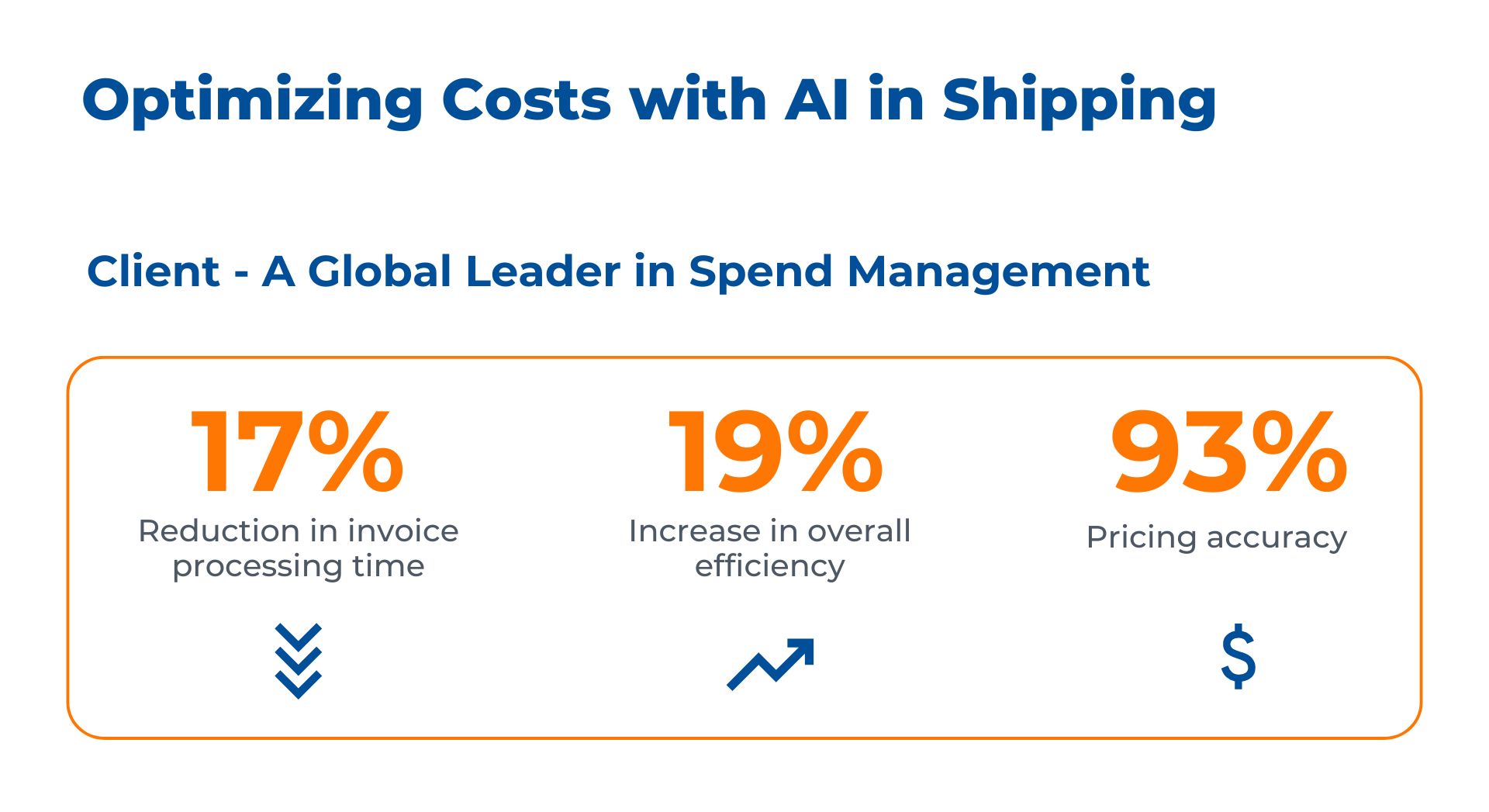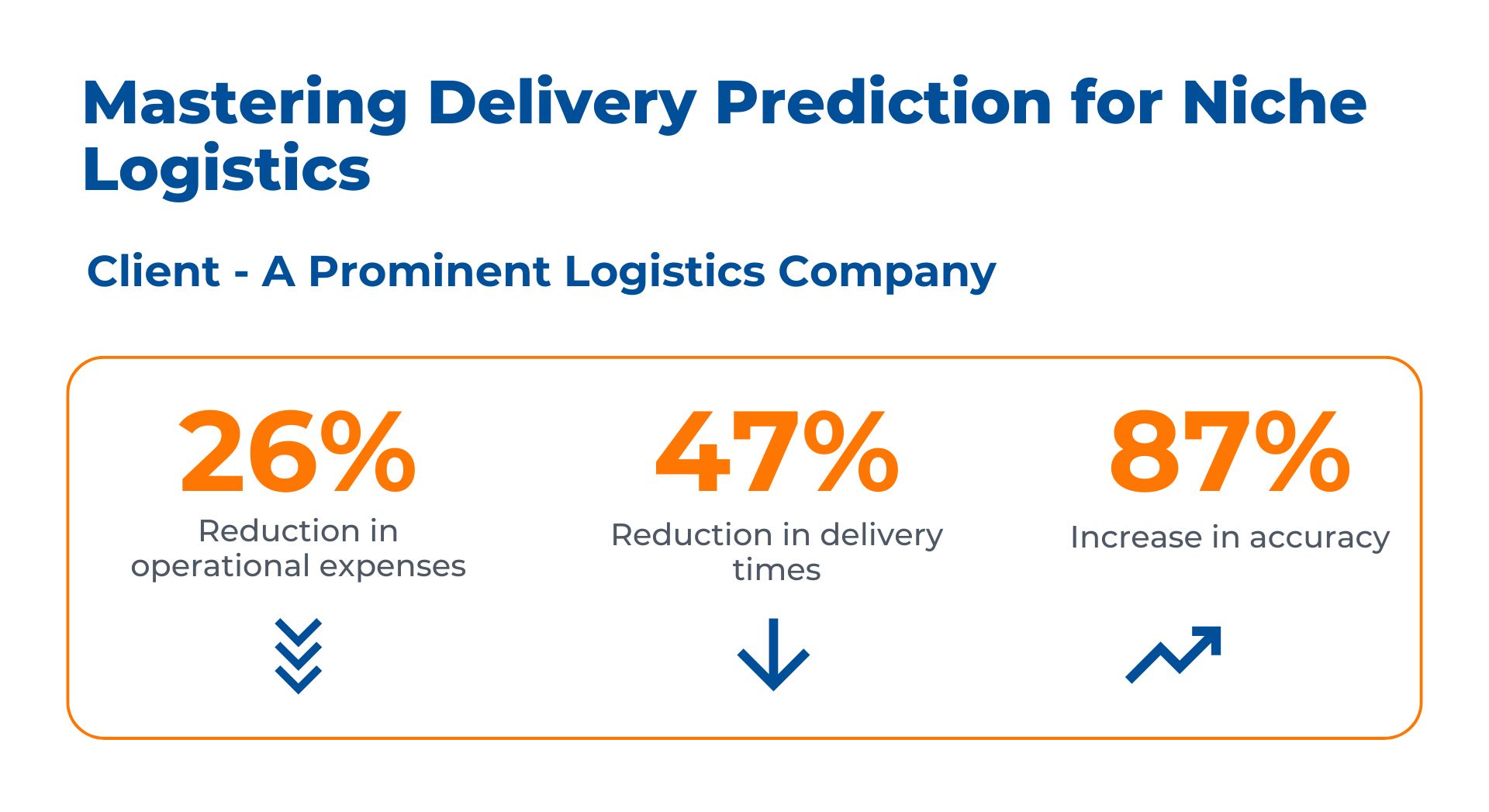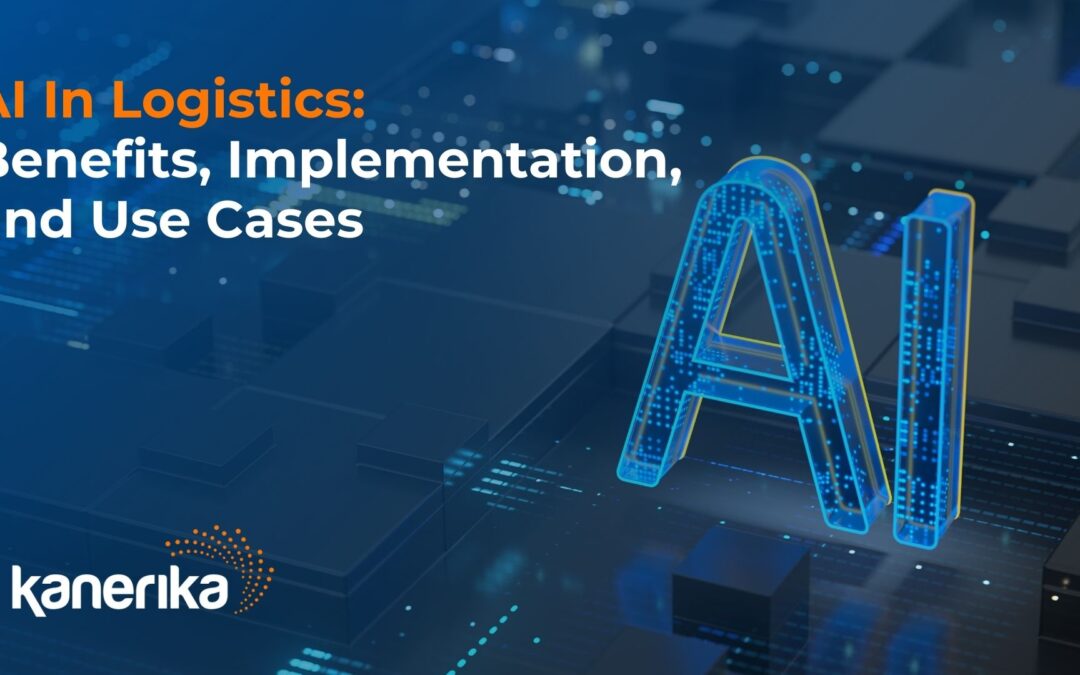The demand for quicker, more efficient delivery services is skyrocketing. Each year, businesses face the challenge of handling over 100 billion parcels globally—a number projected to nearly double by 2030. What if there was a technology that could transform these challenges into opportunities for efficiency and customer satisfaction? The integration of Artificial Intelligence (AI) in logistics emerges as a game-changer. Embracing AI technology in logistics could be the strategic move that propels businesses into a new era of operational efficiency.
Artificial Intelligence (AI) is quickly transforming the logistics industry, offering solutions that can optimize deliveries, predict demand fluctuations, and ensure a smoother delivery of goods not just in holiday season but all year along for both businesses and consumers.
The future of AI in logistics is very promising, with industry analysts forecasting that by 2035, AI could potentially boost logistics productivity by an astonishing 40%. With such significant potential, understanding the benefits, implementation strategies, and real-world use cases of AI in logistics becomes crucial for any business looking to stay competitive in today’s fast-paced market.
Table of Contents
- Common Business Challenges for Logistics Service Providers
- Benefits of Integrating AI in Logistics Operations
- Case Study: Kanerika – Predicting Shipment Cost Using AI
- Steps to Integrate AI in Logistics
- Case Study: Kanerika – Delivery Prediction Model for Logistics Company in USA
- AI in Logistics: Use Cases
- Case study: AI in Logistics
- Kanerika: Your Premier Partner for AI-Driven Logistics Innovation
- FAQs
Common Business Challenges for Logistics Service Providers
Logistics providers operate in a complicated and ever-changing environment. Below are some of the most common problems that these businesses face.
1. Growing Costs and Efficiency
Volatility of fuel prices: Transportation costs change significantly with the cost of fuel. This makes it difficult for them to remain profitable when fuel prices are unstable.
Streamlining transportation: Finding a balance between efficient routes, on-time delivery, and reducing empty miles is always a challenge.
Managing warehouses: Properly utilizing warehouse space, optimizing picking and packing processes, and allocating labor is important for improving efficiency and cost management.
2. Visibility and Tracking
Tracking shipments in real time: Clients expect continuous updates on their respective deliveries, so accurate tracking information within the required timeframe is difficult to provide.
Limited supply chain visibility: Logistics providers often deal with multiple players in complex supply chains; therefore, gaining end-to-end visibility into inventory levels or potential disruptions can be quite challenging.
Poor communication systems: Communication breakdowns among different stakeholders, such as shippers, carriers, customers, etc., can lead to delays or even misinterpretation of orders, adversely affecting service delivery.
3. Customer Demands and Competition
Rising Customer Expectations: Increasing demands for faster delivery times, more flexible options, and transparent communication are setting new standards for businesses, including logistics providers.
Stiff Competition: The logistics service provider market is saturated, necessitating the development of unique solutions that surpass competitor service levels to ensure survival and growth.
Labor Shortages: A significant shortage of highly skilled workers in the logistics sector is reducing productivity and substantially increasing labor costs.
4. Technological Integration
Embracing New Technologies: Keeping pace with frequent technological advances, such as AI and automation, often requires substantial investments with uncertain initial returns.
Data Integration: Generating actionable insights from data across diverse systems like warehouses, transportation, and customer portals presents significant challenges.
Cybersecurity Threats: High volumes of sensitive data make logistics companies prime targets for cybercriminals, necessitating robust security measures to prevent digital attacks.
5. External Factors
Economic fluctuations: Global economic downturns can significantly impact on demand for logistics services, especially during recessions when businesses close down, leading to low uptake.
Geopolitical disruptions: Trade wars, political instability, and natural calamities often interfere with supply chains, resulting in logistical nightmares for most countries affected. Thus, it is difficult for companies operating within such regions to achieve smooth operations across their networks.
Sustainability concerns: Customers and regulators have been mounting requirements for environmentally friendly approaches in freight management; hence, given current global warming trends, firms have no option other than to find sustainable strategies that lower their carbon footprint.
Benefits of Integrating AI in Logistics Operations
1. Boost Efficiency and Automation
Simplified Flows: AI takes over repetitive duties such as data entry, order processing or warehouse picking to enable staff to engage in more valuable tasks.
Enhanced Paths: Through information analysis, AI develops dynamic delivery routes that reduce travel time, fuel consumption, and empty miles.
Anticipatory Maintenance: By predicting equipment breakdowns, artificial intelligence supports proactive repairs, thus preventing costly downtimes.
2. Cost Cutting and Profit Maximization
Saving on Costs: Logistics service providers benefit from cost savings due to optimized routes, automated tasks and decreased maintenance expenses.
Flexible Pricing: Real-time demand-based pricing adjustments by AI models enhance profitability through capacity restriction awareness.
Stock Control Optimization: Optimal stock levels are maintained with the help of AI, which prevents overstocking while minimizing storage costs, too.
3. Boost Customer Satisfaction
Tracking in Real Time: Customers gain more visibility into their shipments thanks to real-time tracking facilitated by AI, thereby enhancing control and transparency throughout deliveries.
Quicker Deliveries: Faster-than-expected deliveries occur when operations are efficient enough and routes are optimized using AI technology.
Proactive Communication: Artificial intelligence can identify potential delays earlier, communicating them before customers become frustrated.
4. Better Decision Making
Data-Based Insights: Decision-making is improved through valuable insights generated by AI from analyzing huge amounts of data.
Forecasting Demand: Businesses can allocate resources better and plan inventory levels and staffing based on accurate future demand forecasts provided by artificial intelligence (AI).
Risk Management: Potential disruptions or delays may be recognized by LSPs in advance for possible risk mitigation measures through the utilization of AI systems.
5. More adaptability and scalability
Dynamic Routing: According to traffic conditions, changes in weather, or other unexpected events happen along the delivery route, and then this route will be adjusted dynamically using an intelligent system like artificial intelligence (AI), among others.
Operational Scalability: When the volume of orders increases significantly or there is a need for expansion into new markets, AI can easily handle such situations without causing disruptions in operations.
Future readiness: AI enables LSPs to prepare themselves adequately so that they may accommodate different technologies and meet changing consumer needs within the logistics industry, which keeps changing over time.
Case Study: Kanerika – Predicting Shipment Cost Using AI
Challenge: A leading logistics company struggled with inaccurate shipment cost estimations. Traditional methods relied on historical data and manual calculations, leading to significant cost discrepancies.
Solution: Kanerika implemented an AI-powered solution for predicting shipment costs. The system analyzed vast amounts of internal and external data, including:
- Historical shipment data
- Fuel prices
- Route information
- Weather conditions
- Market trends
Results:
- Improved Cost Accuracy: AI-powered predictions yielded a significant reduction in cost estimation errors, leading to better budget planning and pricing strategies.
- Reduced Operational Costs: More accurate cost estimations allowed for efficient resource allocation and route optimization, minimizing unnecessary expenses.
- Enhanced Customer Satisfaction: Precise cost estimates enabled the company to offer more competitive pricing and transparent customer communication.

Steps to Integrate AI in Logistics
1. Assess Current Infrastructure and Identify Needs
Evaluate Existing Systems: Conduct a comprehensive audit of current logistics processes, technologies, and infrastructure to identify areas where AI can add value.
Define Objectives: Clearly outline the goals you aim to achieve with AI integration, such as cost reduction, improved efficiency, or enhanced customer service.
2. Collect and Prepare Data
Data Gathering: Collect relevant data from various sources within the supply chain, including transportation, warehousing, and inventory management systems. Ensure the data is comprehensive and covers all critical aspects of your logistics operations.
Data Cleaning and Preparation: Cleanse the data to remove inconsistencies, duplicates, and errors. Organize the data into a structured format suitable for AI algorithms. This step is crucial for the accuracy and reliability of AI models.
3. Choose the Right AI Tools and Technologies
Select AI Platforms: Choose appropriate AI platforms and tools that align with your business needs. This might include machine learning frameworks, predictive analytics tools, and natural language processing (NLP) system tools like Quytech and Carrier Compare.
Consider Cloud Solutions: Evaluate cloud-based AI solutions for scalability and flexibility. Cloud platforms can provide the necessary computational power and storage for large-scale AI applications.
4. Develop AI Models and Algorithms
Algorithm Selection: Based on your objectives, select suitable AI algorithms for tasks such as demand forecasting, route optimization, and inventory management. Popular algorithms include linear regression, decision trees, and neural networks.
Model Training: Train the selected AI models using historical and real-time data. Ensure the models are continuously updated and refined with new data to improve accuracy and performance.
5. Pilot and Test AI Solutions
Run Pilot Projects: Implement AI solutions on a smaller scale to test their effectiveness. This helps identify potential issues and allows for adjustments before full-scale deployment.
Monitor and Evaluate: Continuously monitor the performance of AI systems during the pilot phase. Use key performance indicators (KPIs) to evaluate their impact on efficiency, cost savings, and customer satisfaction.
6. Full-Scale Implementation
Scale Up: Once the pilot projects are successful, roll out AI solutions across the entire logistics operation. Ensure all relevant stakeholders are informed and trained on the new systems.
Integrate with Existing Systems: Seamlessly integrate AI solutions with existing logistics management systems to ensure smooth operation and data flow.
7. Continuous Monitoring and Optimization
Performance Tracking: Continuously track the performance of AI systems against predefined KPIs. With this it helps identify areas for further improvement and ensures the AI solutions continue to deliver value.
Feedback Loop: Establish a feedback loop where data and insights from AI systems are regularly reviewed and used to refine and optimize logistics strategies.
8. Address Challenges and Mitigate Risks
Data Security: Implement robust security measures to protect sensitive logistics data from breaches and cyber-attacks.
Change Management: Manage the organizational change by providing training and support to employees. Address any resistance and ensure a smooth transition to AI-powered logistics.
Case Study: Kanerika – Delivery Prediction Model for Logistics Company in USA
Challenge: A US-based logistics company faced challenges in accurately predicting delivery times. Inconsistent delivery schedules negatively impacted customer satisfaction and brand reputation.
Solution: Kanerika developed a machine learning model for delivery prediction. The model analyzed various factors that influence delivery timelines, such as:
- Traffic patterns
- Weather conditions
- Route complexity
- Historical delivery data
Results:
- Enhanced Delivery Accuracy: The AI model significantly improved the accuracy of delivery time predictions, leading to better customer communication and reduced last-minute changes.
- Improved Customer Experience: Accurate delivery forecasts allowed for proactive updates and a more transparent experience for customers.
- Boosted Operational Efficiency: Knowing delivery windows with greater certainty enabled the company to optimize resource allocation and route planning for improved efficiency.

AI in Logistics: Use Cases
1. Predictive Analytics for Demand Forecasting
Predictive analytics utilizes AI algorithms to analyze historical data, market trends, and customer behavior to forecast future demand for products. This enables companies to manage inventory more effectively, reducing both overstock and stockout situations.
Example: Walmart leverages AI for demand forecasting. By analyzing vast amounts of sales data and external factors such as weather patterns, Walmart can accurately predict product demand, ensuring optimal inventory levels and reducing waste.
2. Route Optimization
AI systems examine current facts on traffic flow, meteorological state and delivery programs so as to opt for the best ways of delivering goods. In doing this, they reduce fuel consumption, minimize the time taken in transportation and cut down on costs.
Example: UPS’s ORION (On-Road Integrated Optimization and Navigation) system uses artificial intelligence in optimizing delivery routes. ORION does this by analyzing many sources of information to establish which among them would be the most efficient for its drivers, thus saving millions of gallons of fuel every year alongside reducing carbon emissions.
3. Warehouse Automation
AI-driven robots and automation systems manage warehouse operations such as sorting, picking, and packing. This increases operational efficiency, reduces human error, and lowers labor costs.
Example: Amazon has employed Kiva robots which are responsible for picking goods from different locations before packing them together for shipment. Additionally, these machines can move around the storehouse while searching for products, bringing about a much faster process than manual labor where one person would have done everything.
4. Predictive Maintenance
Before failures occur, artificial intelligence (AI) analyzes data from Internet of Things (IoT) sensors on machines to predict when they need maintenance. This strategy minimizes downtime and enhances the lifespan of equipment thereby reducing the costs incurred in maintaining it.
Example: DHL ensures its delivery vans are always on the move through predictive maintenance. The Company uses AI to forecast potential breakdowns and prevent them from happening, which could bring operations to a standstill resulting in low reliability levels towards service delivery.
5. Real-Time Shipment Tracking
The tracking of deliveries is available in real time through AI systems, which also tell where cargo is. This increases transparency, makes clients happier and helps to solve problems early enough.
Example: FedEx employs Artificial Intelligence technology to update their customers about the location of their packages on a timely basis. The information given by this method includes the current state of shipment and thus enables consumers to track their parcels accurately as well as predict when they will be delivered.
6. Inventory Optimization
Artificial intelligence (AI) systems can study sales figures, market dynamics and fluctuations across seasons to help businesses manage their stock optimally. This could mean lower holding costs, better cash flow and higher service levels.
Example: Zara applies AI in its inventory management whereby the technology reviews sales histories then anticipate what will be required in future with regards to such items during various periods throughout the year thus ensuring availability while minimizing leftovers or out-of-stocks which would have necessitated markdowns.
7. Quality Control and Damage Detection
During the manufacturing and packaging processes, products are examined for defects and damage by computer vision systems powered by AI. This helps enhance quality while decreasing returns hence increasing customer satisfaction.
Example: Bosch applies artificial intelligence in its logistics division to ensure quality control. This is done so that only good quality products get delivered to customers; thereby minimizing returns and improving client contentment levels.
8. Fraud Detection and Security
To detect and prevent fraudulent activities in the logistics process, AI systems scrutinize transactional data as well as patterns. This in turn heightens security, cuts down on theft and fraud losses and guarantees compliance with regulations.
Example: Logistics companies employ AI-backed security systems for monitoring abnormal behaviors that may pose a threat to security; such systems also notify managers about potential security risks so that necessary action can be taken. Moreover, such measures play a role in protecting goods from being stolen while at the same time ensuring that supply chain management proceeds without any hitches.
9. Supplier Risk Management
AI examines supplier performance, financial soundness and conformity to pinpoint dangerous areas. This drastically improves the selection process, cuts off disturbances within supply chains and strengthens strategies for managing risks.
Example: L’Oréal uses artificial intelligence systems for risk assessment among its suppliers. By considering multiple risk indicators, this AI system enables L’Oréal to have a firm and dependable supply chain that ensures constant availability of products.
Case study: AI in Logistics
Kanerika: Your Premier Partner for AI-Driven Logistics Innovation
At Kanerika, our AI expertise ensures you overcome challenges in logistics operations, enhance efficiency, streamline processes, and maximize ROI. We specialize in optimizing resources with strategic AI solutions tailored to meet your specific business requirements. Our track record of successful AI integration in logistics is a testament to our ability to deliver outstanding results.
With Kanerika, you can expect:
- Enhanced Efficiency: Streamline your logistics operations and reduce costs.
- Process Optimization: Implement AI-driven solutions for better resource management.
- Maximized ROI: Achieve higher returns with our innovative AI strategies.
- Tailored Solutions: Customized AI strategies to meet your unique business needs.
Our proven expertise will help you outsmart competitors and stay ahead in the market. Experience the power of AI-driven logistics innovation with Kanerika.



















